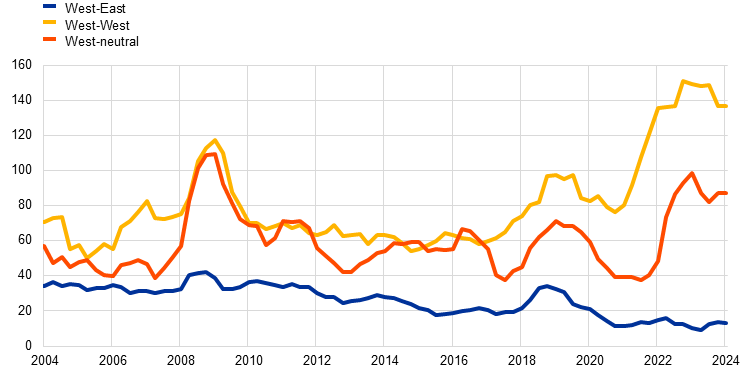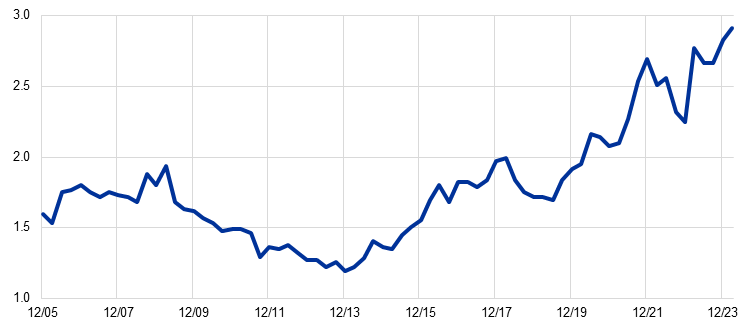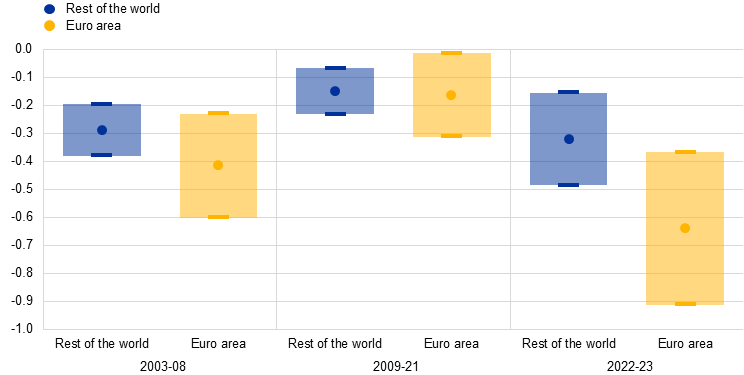Geopolitical fragmentation in global and euro area greenfield foreign direct investment
Prepared by Lukas Boeckelmann, Lorenz Emter, Isabella Moder, Giacomo Pongetti and Tajda Spital
This box reviews recent developments in global and euro area greenfield foreign direct investment (FDI) and analyses the role of geopolitics in shaping these. As firms and policymakers increasingly look at ways to reduce the vulnerability of their supply chains, understanding recent dynamics in greenfield investment is important as these may foreshadow a reconfiguration of global trade networks, the fragmentation of which could be particularly detrimental for the euro area.[1] Greenfield FDI flows refer to foreign investments made by companies to build new or extend existing production capacity. In the last decade, annual FDI outflows and inflows amounted to 1.4% and 0.6% respectively of euro area GDP and 1.0% and 1.2% respectively of global GDP excluding the euro area. The euro area is the largest source of outward greenfield FDI, accounting for 19% of global outflows in the last two years, followed by the United States, which accounted for 15%. This box uses information on announced greenfield FDI projects from a dataset provided by fDi Markets.[2]
Ex ante, the effect of geopolitical fragmentation on the direction of FDI flows is ambiguous. On the one hand, firms and policymakers might look to friend-shore and/or near-shore production to make supply chains less vulnerable to geopolitical tensions or to safeguard their assets from potential future violations of property rights. On the other hand, firms might increase their investments in geopolitically distant countries, i.e. countries which take an observably different stance on foreign policy issues, if they think that future trade tensions might impede their access to local markets.
Aggregate greenfield FDI flows are already showing increasing signs of fragmentation along geopolitical fault lines. Western companies have been ramping up investment in friendly (western) countries, while lowering investment in geopolitically distant (eastern) countries.[3] Greenfield FDI flows within the western bloc have been on the rise since 2016, while flows between the eastern and western blocs have declined, suggesting that western companies are increasingly friend-shoring or near-shoring their production capabilities (Chart A). The increase in greenfield investment within blocs is in line with evidence collected from earnings calls, which have seen a noticeable uptick in references to “friend-shoring”.
Chart A
Global greenfield FDI flows
(four-quarter moving averages, USD billions)

Sources: fDi Markets and ECB staff calculations.
Note: The latest observations are for the first quarter of 2024.
Euro area outward flows have followed the same trend, with greenfield investments increasingly tilted towards geopolitically friendly countries, such as the United States. Euro area FDI outflows seem to be increasingly pulled towards western bloc countries, in particular the United States. One driver may be that euro area firms are trying to increase their local production content for the US market in response to incentives created by the US Inflation Reduction Act (IRA).[4] Flows of greenfield FDI into the euro area are, in turn, dominated by US investments, which accounted for more than 30% of overall inflows in 2023. The recent pick-up in investment in the euro area appears to be part of a broader trend of rerouting US investments away from China to the benefit of more friendly and neutral countries.
While flows between opposing blocs have been relatively contained, there is also evidence that firms have stepped up investment between geopolitical blocs in anticipation of protectionist measures and retaliatory tariffs. Available data suggest that the flow of Chinese FDI to the neutral and western blocs increased steeply around the time the IRA was passed into law. This suggests that, in response to the heightened domestic content requirements introduced by the IRA, Chinese firms shifted their production in order to bypass the trade restrictions imposed on their goods (Chart B, panel a). This mirrors similar developments after 2016 when the threat of higher US tariffs on Chinese goods coincided with an increase in Chinese FDI flows to the western and neutral blocs. Moreover, while overall greenfield FDI flows from the euro area to China are on a declining trend, German firms, mainly driven by the automotive sector, have increased their investment in China in recent years. At the same time, we see evidence of Chinese companies increasing domestic production content in the EU, mostly in non-euro area countries, particularly Hungary (Chart B, panel b). This might also be due to firms pre-emptively relocating their production in anticipation of rising trade tensions.
Chart B
Greenfield FDI from China
a) Chinese outbound FDI to geopolitical blocs |
b) Chinese outbound FDI to the EU and the euro area |
|---|---|
 |
 |
Sources: fDi Markets and ECB staff calculations.
Notes: The vertical line in panel a) refers to the third quarter of 2022, the period when the IRA was signed into law. The latest observations are for the first quarter of 2024.
A more formal econometric analysis suggests that fragmentation along geopolitical fault lines has increased over time. We employ a gravity model for FDI flows that distinguishes between flows within the western and eastern blocs and flows between the blocs.[5] The results suggest that trends in global FDI flows along geopolitical fault lines, as shown in Chart A, were not driven by country-specific characteristics (such as economic growth) and instead reflect increasing geopolitical fragmentation. Independent of geographic distance, it is estimated that FDI flows within geopolitical blocs were almost three times higher than FDI flows between geopolitical blocs in the three years up to the first quarter of 2024 (Chart C).
Chart C
Ratio of FDI flows within blocs to FDI flows between blocs
(ratio)

Source: ECB staff calculations.
Notes: The chart plots the ratio of the coefficients of FDI flows within the western and eastern blocs to the coefficients of FDI flows between the two blocs, estimated using a gravity model for 12-quarter rolling windows between the first quarter of 2003 and the first quarter of 2024. The latest observation is for the first quarter of 2024 and refers to an estimation period between the second quarter of 2021 and the first quarter of 2024.
Econometric evidence shows that the overall effect of geopolitical divides on FDI is negative. We find that the effect of geopolitical distance on global and euro area greenfield FDI flows has increased since Russia’s invasion of Ukraine (Chart D).[6] Our estimates suggest that the widening geopolitical divide has dampened global FDI flows by around 3% (or €30 billion).[7] For the euro area, the value of announced greenfield FDI projects is also significantly smaller in destination countries that are geopolitically more distant, and this negative relationship has become much more pronounced since the Russian invasion of Ukraine, with annual flows falling by €14 billion. Moreover, we find that the increase in geopolitical distance between the euro area and China over the same period is associated with a decrease of around 20% in the value of flows between the two areas.[8]
Chart D
Effect of geopolitical distance on value of bilateral greenfield FDI flows over time
(elasticities, percentages)

Sources: fDi Markets and ECB staff calculations.
Notes: The chart plots the coefficients of geopolitical distance for the euro area and the rest of the world, estimated using a gravity model following Aiyar et al., op. cit. Dots depict point estimates while bars refer to the 95% confidence interval. Intra-euro area flows are excluded.
The impact of the shifts in FDI on trade and euro area output remains uncertain. On the one hand, a shift by euro area firms to increase production in the United States or other countries – for example, in response to domestic content requirements – may dampen production at home. On the other hand, higher FDI outflows may safeguard the overall competitiveness of European exporters and may, for example by increasing FDI income streams, preserve some domestic jobs, particularly in high-skilled corporate services. Moreover, euro area and other EU countries also appear to have benefited from inward FDI, which has averaged 0.7% of GDP since 2022, exceeding pre-pandemic levels.[9] More broadly, to the extent that a change in global greenfield FDI patterns along geopolitical lines foreshadows an accelerating fragmentation of global trade networks, the trends detected may prove detrimental to global and euro area output. Given its greater openness to trade and stronger integration into global value chains, such fragmentation would be more detrimental for the euro area than for other large economies.[10]
Legal Disclaimer:
EIN Presswire provides this news content "as is" without warranty of any kind. We do not accept any responsibility or liability for the accuracy, content, images, videos, licenses, completeness, legality, or reliability of the information contained in this article. If you have any complaints or copyright issues related to this article, kindly contact the author above.
